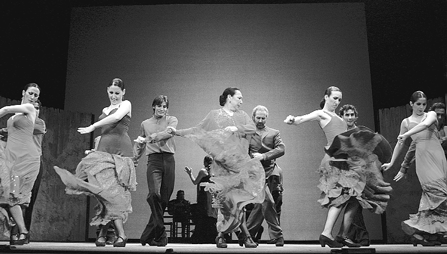Southern flair at the New York Flamenco Festival
Program notes for “Viaje al Sur” (Journey to the South)—presented by Ballet Flamenco de Andalucía at World Music Institute’s 6th Annual New York Flamenco Festival—invited NY City Center’s audience to “learn to feel without [concern for] the consequences.” As far as I could tell, the most serious consequences included developing a crush on Cristina Hoyos’ Seville-based troupe and then experiencing crushing disappointment at not having won WMI’s raffle for a trip to southern Spain.
Choreographed by Hoyos with stage direction by Ramón Oller, “Viaje al Sur” unfolded in three movements—”Happiness,” “Tragedy,” and “Passion”—the very essence of flamenco. Voluminous silky drapery traversed the stage, symbolizing each passage––filmy white for happiness, velvety black for tragedy, and flaming red for passion. Unlike more intimate flamenco presentations such as the magnificent Soledad Barrio’s no-frills, white-hot “Noche Flamenco,” “Viaje al Sur” trades in expansive, bustling theatricality, and for the most part makes it work.
Led by Hoyos—veteran performer and award-winning dancemaker—the performers included three singers, two guitarists, a percussionist, and a cast of 14 male and female dancers. El Junco, a playful, sunny dancer with feet like a jackhammer, contributed solo highlights. Most of the dance numbers proceeded at a good clip yet this 90-minute, intermission-less journey could have benefited from judicious trimming.
In “Viaje’s” best moments, every part of the stage breathed with life, aroused and powerful. Transitions from ensemble parts to duets or small groups, and back to ensembles, flowed with impressive charm and ease. Speedy steps, turns, and armwork as well as the continuous, crisscrossing sweep of dancers across space always gave our eyes something fresh for feasting. While some segments stretched on, most commanded and rewarded our attention.
For the exuberant “Happiness” section, Mercé Paloma dressed each gentleman in a vested suit and each lady in ruffles and flounces in variations of muted shades—ivory, beige, and yellow ochre—creating a feeling of nostalgia for a romantic era. Paloma’s designs, in this opening and throughout the piece, aptly suited and enhanced the quicksilver look of Hoyos’ stagecraft.
The women especially excelled at quick-stepped and powerful movements, displaying flamenco’s proud upper body carriage as well as resilience and vibrancy in their torsos. They were no less attentive to facial expression and dramatic attitude.
It was fun to watch Hoyos parade past a crisp line of men, carrying herself like a dowager empress inspecting her handsome troops. However, her lengthy solos too often impeded “Viaje’s” momentum, and the broad mimesis of her soleá in “Tragedy,” unwisely evoking a signature movement from “The Dying Swan,” undermined the intended dignity of this section. Nevertheless, her dancers could not have a finer guide than Hoyos, and the heartiest aspects of her spirit—exactitude, confidence, and generosity—can be felt throughout their individual and ensemble performances.
In “Viaje al Sur,” Ballet Flamenco de Andalucía offers one of the many available flavors of theatrical flamenco––an art form that continues to reinvent itself throughout the world. This ravishing company beckons us into flamenco’s heartland—a journey well worth taking.
gaycitynews.com



































